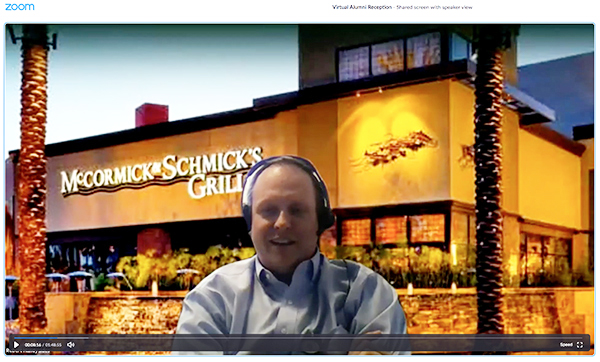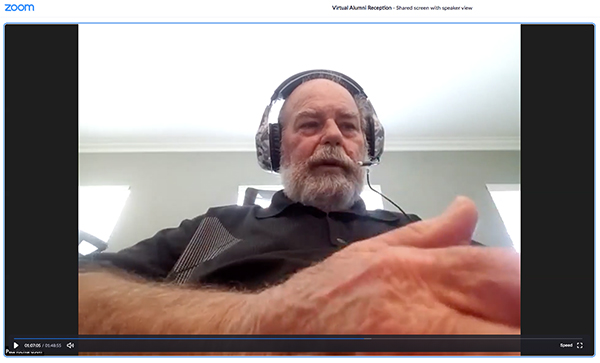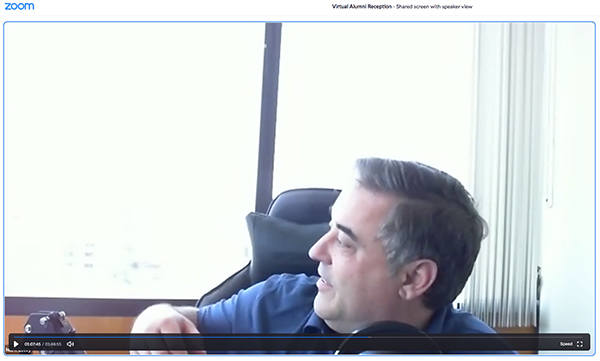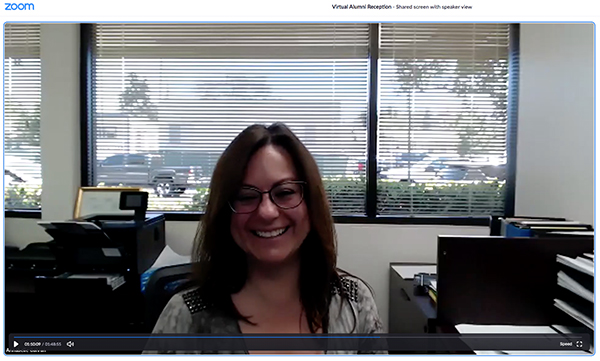
With the announcement by the California Dental Association on March 19 that due to COVID-19 its annual CDA Presents the Art and Science of Dentistry convention in Southern California’s Anaheim Convention Center was canceled, the LLU School of Dentistry lost more than a convention booth; it lost an opportunity that had become a tradition—to reconnect with any of its southwestern United States alumni who ordinarily would have attended the spring 2020 CDA convention.
 Dean Robert Handysides, DDS’93, hosts the School of Dentistry’s first virtual reception.
Dean Robert Handysides, DDS’93, hosts the School of Dentistry’s first virtual reception.But LLUSD Dean Robert Handysides, DDS’93, would not permit a worldwide viral contagion to preclude the opportunity to fellowship with the School’s graduates. And so with the assistance of Alumni Affairs (Kathleen Moore and Jeri Fowler) and the Office of Marketing (Krista Weymar and Leigh Ann Evans), in the first week of May a geographical swath of Southern California alumni were invited to congregate at a virtual reception on Zoom at 1:00 pm, on Friday, May 15. A soylent reception.
 Paul Richardson, DDS’72, MED, associate dean, Clinic Administration
Paul Richardson, DDS’72, MED, associate dean, Clinic AdministrationThe 71 registrants were emailed a link and a code to present at the Zoom online reception waiting room.
Dean Handysides held court, backed by a late afternoon digital exterior of McCormick & Schmick’s Grill—the eatery between the Convention Center and Disneyland where the dean’s reception had taken place in recent years.
 Mark Estey, DDS’98, assistant dean, Academic Affairs, looks from his office window toward the Loma Linda University Church.
Mark Estey, DDS’98, assistant dean, Academic Affairs, looks from his office window toward the Loma Linda University Church.The Zoom experience is new to most of its School of Dentistry users and takes a little getting used to. If you speak, or laugh, or cough, your face (and whatever is behind you) may take over the primary screen of all the participants, until someone else speaks or continues speaking (unless you have your sound and/or camera capability turned off).
There was considerable good-natured banter among the early arrivals as they greeted one another and remarked the rebarbative times we are surmounting. And then, without having to clear his throat or tap the mike, Dean Handysides welcomed the attendees and offered a word of invocation.
 Krista Weymar, MBA, director, Office of Marketing, appears prepared to enjoy a sumptuous buffet.
Krista Weymar, MBA, director, Office of Marketing, appears prepared to enjoy a sumptuous buffet.Loma Linda and COVID-19
The dean spoke for a few minutes about the state of things at Loma Linda—how the University Hospital shut down elective procedures and prepared for a COVID-19 tsunami of up to 450 patients—preparation that included the possibility of commandeering the institution’s parking structures and plasticizing them off into COVID units. “But we were spared,” he said; and “the main hospital reached just 30-35 COVID patients with nearly as many suspected in the Children’s Hospital.”
Before LLUH had COVID testing capabilities, Dean Handysides explained, “the Medical Center’s burn through PPE supplies was huge. Hardest things to find are face shields and N95 masks and disposable gowns.”
 Anabelle Galvin, senior administrative assistant, Continuing Dental Education, monitors the event.
Anabelle Galvin, senior administrative assistant, Continuing Dental Education, monitors the event.Now, with four methods of COVID testing (some external, some internal), and a turn-around time of 24 hours, he said the burn through N-95 masks has greatly reduced.
During the last week in May, the hospital will be opening up for elective procedures, the dean announced. Meanwhile, the Medical Center was accomplishing approximately 1,200 online, virtual medical consults daily, he said.
School of Dentistry’s COVID challenges
Dean Handysides described the School’s “overriding concern for its personnel, students, and patients.” But then he described four categories of pandemic related adjustment.
First was the need for appropriate personal protection equipment (PPE).
This is our huge challenge, he explained, because we had not stocked N95 masks,” he said. “If we brought everybody back and put our students out on the clinic floor, we’d have enough N95s for about two hours.”
The dean indicated that the School has “a good supply of Level 2 and Level 3 masks.” And he was appreciative of the effort members of our clinical and research personnel have been concentrating on the possibility of 3D mask printing—“an amazing team of about 20 folks researching and testing possible mask and face shield solutions.” He also mentioned “a group of our personnel that have been formally testing a 3D printed mask frame that would go over a regular mask and provide an improved seal. “But until we have confidently tested solutions,” the dean cautioned, “we will not make recommendations to our community.”
“The country,” he put the problem in context, “is producing 50 million N95 masks a day but burning through 300 million every day.”
The Dean’s second category of adjustment was “heavy duty screening. Everyone who enters Prince Hall is asked a series of questions regarding a gamut of symptomatic indicators. No one enters the building without their temperature taken.”
Category three is testing. Dean Handysides said, “We are titrating people with symptoms in collaboration with the medical center.”
Category four, aerosol reduction, is a complicated challenge and Dean Handysides elaborated on the School’s mitigation efforts.
“We are attempting to index those procedures that produce light-to-no aerosol production versus moderate-to-heavy and find ways to ameliorate any dispersion.
“LLUSD has the advantage of employing electric, rather than air-driven, hand pieces.”
The dean mentioned the options of “turning off the air and running the hand pieces with just water. And,” he added, “running hand pieces at less than 100,000, generates more of a droplet than an aerosol.”
The dean also suggested, “Four-handed dentistry and rubber dams are additional ways of attempting to limit the proliferation of contaminated particulate.”
Dean Handysides had just attended a meeting with North American dental school deans grappling with their shared challenge of large, open clinics and the need to social distance and aerosol mitigate. He spoke of the exploration of ultraviolet (UV) light to deactivate viral and bacterial sources. LLUSD, he said, has been using UV light in the lab to sterilize some of its masks. But now, he added, “there is a better system at the hospital that uses hydrogen peroxide sterilization for N95 masks.”
“The School’s clinic administration has been helping to develop protocols for screening patients online in a teledentistry manner, so we can get them triaged,” the dean indicated, but he added, “nothing like what our medical colleagues are doing.”
For those who have been following the international debate over legitimate or efficacious treatment by physicians for COVID-19 patients, in an interesting aside, Dean Handysides mentioned the fact that “the LLU Medical Center throws anticoagulants at any COVID-diagnosed patients to reduce infarction rates.”
The Dean addressed the daunting problems students and instructors are facing. He made clear that going forward indefinitely much of the School’s didactic education would be presented through online lectures and distance learning modules.
But some aspects of dental education cannot be virtual. LLUSD “student labs will divide up into four sessions and run from 7:00 am to 9:00 pm,” the dean explained. And he remarked how “under the circumstances licensing exams are a huge thing for our D4s.”
“Some states,” he reported, “are accepting for dental licensing Objective Structure Clinical Examinations (OSCEs): Alaska, Oregon, Washington, Michigan,” he mentioned, “and other states are accepting graduation as licensing.”
The dean indicated that LLUSD will be running a manikin-based WREB in the School’s clinics for D4 students.
Regarding licensing and graduating on time, the dean said, “We have COVID approval to graduate our students as long as we could show that they are competent. Fortunately, in shuffling our curriculum most of our competency assessments had been done by December 2019. We anticipate all of our D4 and IDP students graduating on time in June.”
Pandemic finances
Regarding survival, Dean Handysides was adamant and candid: “We have to restart. Fiscally we’re dying. We have a lot of tough choices ahead of us.
“We have a large number of people on furlough right now. The majority of people on furlough are protected in the sense that the state and federal government are coming in and they can collect unemployment that will either make them whole or in some cases make them better than if they were working at the dental school.
“The financial health of the University as a whole and the School of Dentistry is not a great thing. We’re losing money, but then what dental office in our community isn’t losing money. We used to see 1,000 patients a day . . . It’s a major hit and it will have lingering aspects for us that we will have to work our way through.”
The dean spoke gratefully of an alumnus who donated very generously toward serology tests for medical and dental staff. And he reported a $100,000 student support challenge fund from another alumnus. The challenge was matched and funds have been going out to students in different ways. “So, every one of 4,000 students on campus got $300-some,” he calculated.
Dean Handysides said that Dental Hygiene “is managing by staying home. Obviously, the use of a cavitron is a no-no right now. We are trying to add in an extra volume of suction for clinic operations to try and minimize aerosol dispersal. One way to get DH back in operations,” he added.
The dean said he anticipates having dental hygiene seniors with us part way through the summer to be able to make up some of their requirements.
Dental education’s future
Dean Handysides spoke about the summer quarter beginning in early July and the challenge of “working out the social distancing logistics for where students normally would congregate in halls.”
Social distancing will require that “our education is going to be didactically online,” the dean explained. “We have to deliver all of our lectures in a whole new way. The 350-seat Damazo Amphitheater can only handle 70 students for a social distancing-appropriate lecture. As long as there is a six-foot social distancing rule, we don’t have the space.”
Dean Handysides concluded, “Unfortunately, things will be different at the dental school when we come back.”
Virtual visits with the dean
Dean Handysides looks forward to continuing virtual visits with regional clusters of alumni through online events. The next opportunity for alumni to meet with the dean virtually will be Wednesday, June 10, at 6 pm, specifically for alumni in Central and Northern California, Oregon, and Washington State.
